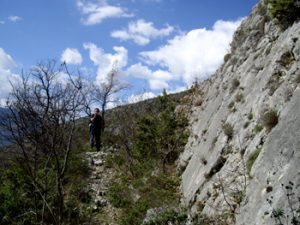
to understand how the lower crust, nine miles below, influences earthquakes.
Credit: Joanna Faure Walker, University College London
Most earthquakes erupt suddenly from faults near Earth’s surface, and the big ones can topple cities. But miles below, rocks heated to the consistency of wax moving over thousands to millions of years may be the driving force behind some of these events. In a new study in the journal Nature Geoscience, scientists link rapid-fire destruction on the surface to the hyper-slow flow of rocks in Earth’s lower crust. The study also shows that the weight of overlying mountains causes these deep rocks to strain at a rate that determines the frequency of large earthquakes on overlying faults; the scientists say that this relationship follows simple mathematical laws that were known from lab experiments.
“This tells us that the earthquake-prone faults in the shallow part of the crust are directly rooted into the flowing material at depth,” said the study’s lead author, Patience Cowie, a geologist at the University of Bergen in Norway.
The study is based on measurements taken from Italy’s earthquake-prone Apennine Mountains, where a magnitude 6.3 earthquake in L’Aquila in 2009 killed more than 300 people. The Apennines bear scars from past seismic activity in the form of fault scarps, marking where land has slipped down on the faults. Working in the central and southern Apennines, Gerald Roberts and Joanna Faure Walker, geologists at University College London, measured how much the scarps had moved, and in which direction, to reconstruct deformation rates over the past 10,000 years.
Their results, presented at a conference in Greece in 2011, caught the eye of study coauthor Christopher Scholz, a geophysicist at Columbia University’s Lamont-Doherty Earth Observatory. At each fault, Scholz noticed that elevation appeared closely linked to the deformation rate, suggesting that the gradual flow of deep crust, more than nine miles down, was placing strain on the fault. The researchers hypothesize that stress from the weight of the mountains cause shear zones in the deep crust to deform, determining how often the fault will slip to produce earthquakes. The deformation rate data from the Apennines closely matched that from lab experiments showing that rocks in deep shear zones strain at a rate proportional to the cube of the stress.
“The higher the elevation, the faster the faults are sliding,” said Scholz. “As long as you’re pushing up on the mountains, they grow, but they always want to collapse because of gravitational forces. After the tectonics that’s pushing them stops, as in the Apennines, they collapse under their own weight.”
A related conclusion is that a doubling of the topographic elevation corresponds to an eight-fold increase in the deformation rate. That means faults located in lower elevation areas that have not ruptured in historical times may still be active but with longer periods of inactivity between earthquakes due to their lower deformation rate.
The study offers an elegant way to understand the nature of deformation in the lower crust and how it influences earthquakes, said Roland Bürgmann, a geophysicist at the University of California at Berkeley who was not involved in the research. “To understand the real world, we need to simplify it, which they do by making a lot of assumptions, but it does look like an intriguing relationship,” he said.
It is unclear if the researchers’ model can be fully applied to other earthquake-prone areas. Other mountain belts like the Himalayas are being deformed by horizontal stresses and are still in the mountain-building phase, while the Apennines are currently collapsing under the action of vertical stresses. Still, the Apennines have allowed researchers to discover how the deep crust behaves which can be applied anywhere, said Scholz.
Note : The above story is based on materials provided by Columbia University










